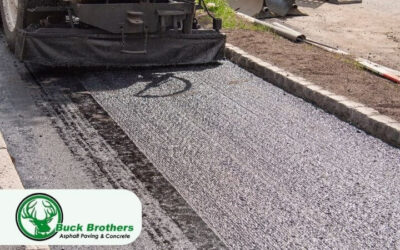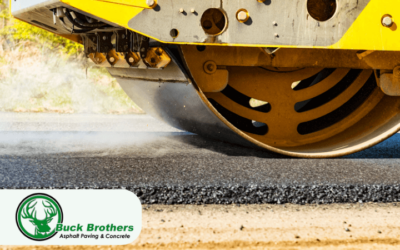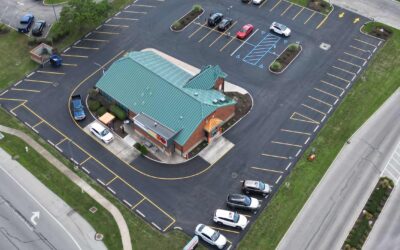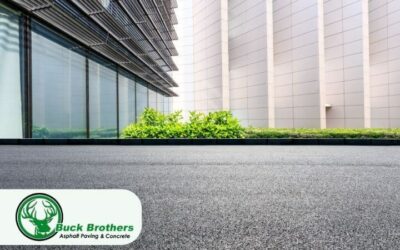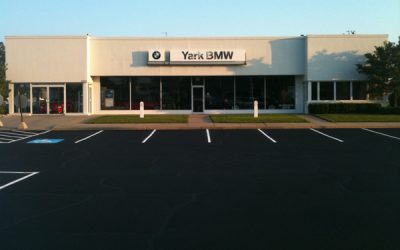As a business owner, you know that first impressions matter. Your parking lot is often the first thing customers see when they arrive at your establishment, and it can significantly impact their perception of your brand. At Buck Brothers, we understand the importance of quality and appearance, which is why we specialize in top-notch parking lot construction. A well-constructed, attractive, and properly maintained parking lot not only enhances your property’s curb appeal but also ensures the safety and satisfaction of your customers. In this comprehensive guide, we’ll explore the key factors to consider when constructing a parking lot for your business, including choosing the right material, implementing effective design principles, and maintaining your lot for long-lasting performance. Trust Buck Brothers for expert commercial asphalt services that deliver superior parking lot construction, ensuring your business makes the best possible first impression.
Choosing the Right Material
One of the most crucial decisions you’ll make when constructing a parking lot is selecting the appropriate material. The two most common options are concrete and asphalt, each with its own set of benefits and drawbacks. Let’s take a closer look at both materials to help you make an informed decision for your business.
Concrete
Concrete parking lots are known for their durability and longevity. A properly constructed concrete lot can last up to 30 years or more with minimal maintenance. This material is resistant to heavy loads, making it ideal for businesses that experience high traffic volumes or have frequent deliveries from large trucks. Concrete also offers a clean, modern appearance that can be customized with various finishes, colors, and patterns to match your business’s aesthetic.
In addition to its durability and visual appeal, concrete is an environmentally friendly choice. It reflects more light than asphalt, reducing the heat island effect and helping to keep surrounding areas cooler. This reflective property also means that concrete parking lots require less lighting, leading to energy savings for your business.
However, it’s important to note that concrete typically has a higher upfront cost compared to asphalt. The installation process is also more time-consuming, as the material needs to cure properly before use.
Asphalt
Asphalt parking lots are a popular choice for businesses due to their cost-effectiveness and relatively quick installation process. Asphalt is less expensive than concrete and can be installed in a shorter timeframe, minimizing disruption to your business operations. This material is also easier to repair than concrete, as small cracks and potholes can be filled in without requiring extensive work.
Asphalt performs well in a variety of climates, as it is flexible and can withstand minor ground shifts and temperature changes. However, it does require more frequent maintenance than concrete to ensure its longevity. Asphalt parking lots typically need to be sealed every 2-3 years and resurfaced every 8-10 years to maintain their appearance and structural integrity.
One drawback of asphalt is that it is less visually appealing than concrete and may not offer the same level of customization options. It also absorbs more heat, which can contribute to the urban heat island effect and may require more lighting to ensure safety during low-light conditions.

Parking Lot Design
Once you’ve selected the material for your parking lot, it’s essential to focus on designing a functional, safe, and visually appealing layout. A well-designed parking lot not only maximizes space efficiency but also promotes smooth traffic flow and minimizes the risk of accidents.
Size and Layout
The first step in designing your parking lot is determining the appropriate size based on your business’s needs. Consider factors such as the number of customers you expect during peak hours, the types of vehicles that will be using the lot (e.g., cars, trucks, motorcycles), and any additional space requirements for landscaping or pedestrian walkways.
When planning the layout, aim to create a logical and efficient flow of traffic. Use angled parking spaces to maximize capacity and make it easier for vehicles to navigate the lot. Incorporate clear directional markings and signage to guide drivers and minimize confusion. If your lot will accommodate both cars and larger vehicles like trucks or RVs, designate specific areas for each type to ensure safety and convenience.
Don’t forget to incorporate landscaping elements into your design. Strategically placed trees, shrubs, and planting beds can enhance the visual appeal of your parking lot while also providing shade and reducing the heat island effect. Just be sure to choose low-maintenance, native plant species that won’t obstruct visibility or interfere with parking lot operations.
Safety Features
Ensuring the safety of your customers and employees should be a top priority when designing your parking lot. Adequate lighting is crucial for maintaining visibility and deterring criminal activity. Install high-quality, energy-efficient lighting fixtures throughout the lot, paying extra attention to pedestrian walkways, entrances, and exits.
Clear signage and markings are also essential for promoting safety. Use bright, reflective paint to delineate parking spaces, crosswalks, and directional arrows. Post speed limit signs and other relevant notices to encourage safe driving habits. Ensure that your lot complies with the Americans with Disabilities Act (ADA) by including designated handicapped parking spaces and accessible routes to your business entrance.
Drainage and Grading
Proper drainage and grading are critical components of a well-functioning parking lot. Standing water can not only create safety hazards for pedestrians and vehicles but also accelerate the deterioration of your parking lot surface. To prevent these issues, design your lot with a slight slope (typically 1-2%) to facilitate water runoff towards drainage points, such as catch basins or retention ponds.
The specific drainage and grading requirements for your parking lot may vary depending on local regulations and site conditions. Consult with a professional engineer or contractor to ensure that your design complies with all applicable codes and standards.
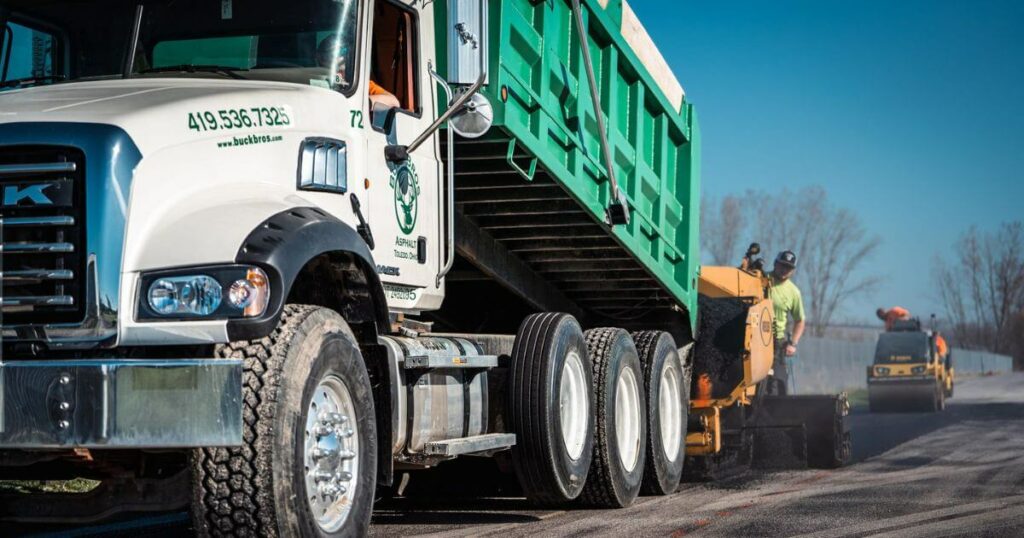
Construction Process
With your material selected and design finalized, it’s time to bring your vision to life. The construction process for a parking lot involves several key stages, each requiring careful planning and execution to ensure a high-quality, long-lasting result.
Site Preparation
Before any paving can begin, the construction site must be properly prepared. This involves clearing the land of any existing vegetation, debris, or structures. The area is then graded to achieve the desired slope and level surface. If the soil is unstable or prone to settling, additional measures like soil stabilization or the installation of a sub-base may be necessary to provide a solid foundation for the parking lot.
Installation Techniques
The installation process varies slightly depending on whether you’ve chosen concrete or asphalt for your parking lot.
For concrete, the installation typically involves the following steps:
- Forms are set up to define the edges of the parking lot and create any necessary joints or divisions.
- Reinforcing steel or wire mesh is laid out to provide additional strength and prevent cracking.
- The concrete is poured, leveled, and smoothed using specialized equipment.
- The surface is finished with a broom, trowel, or other texturing tool to create a slip-resistant surface.
For asphalt, the process usually includes:
- A base layer of compacted gravel is installed to provide stability and improve drainage.
- The asphalt is heated to the appropriate temperature and then spread evenly over the base layer using a paving machine.
- The surface is compacted using a heavy roller to achieve a smooth, dense finish.
Regardless of the material used, it’s crucial to work with experienced professionals who adhere to industry best practices and use high-quality equipment to ensure a smooth, even surface that will stand the test of time.
Curing and Finishing
After the parking lot surface has been installed, it needs to undergo a curing process to reach its full strength and durability. For concrete, this typically involves keeping the surface moist for several days to slow down the drying process and prevent cracking. Asphalt, on the other hand, requires time to cool and harden fully.
Once the curing process is complete, you may choose to apply additional finishes or coatings to protect the surface and enhance its appearance. For example, concrete can be sealed with a protective layer to resist staining and moisture intrusion, while asphalt can be sealcoated to prevent oxidation and extend its lifespan.

Maintenance and Repair
Even the most well-constructed parking lot will require regular maintenance and occasional repairs to keep it looking and functioning its best. By implementing a proactive maintenance plan, you can extend the life of your parking lot and minimize the need for costly repairs down the line.
Regular Cleaning and Upkeep
One of the simplest and most effective ways to maintain your parking lot is through regular cleaning. Sweep the surface frequently to remove debris, dirt, and leaves that can accumulate and trap moisture against the pavement. For a deeper clean, use a pressure washer to remove stubborn stains and grime, being careful not to damage the surface with excessive water pressure.
In addition to cleaning, it’s important to keep an eye out for any signs of damage or wear, such as cracks, potholes, or fading striping. Addressing these issues promptly can prevent them from escalating into more serious and expensive problems.
Sealcoating and Restriping
Sealcoating is a preventive maintenance measure that involves applying a protective layer over the surface of your asphalt parking lot. This coating helps to:
- Prevent oxidation and UV damage
- Resist moisture infiltration
- Minimize the effects of oil and chemical spills
- Extend the overall lifespan of the pavement
Experts recommend sealcoating asphalt parking lots every 2-3 years, depending on factors like traffic volume, climate, and the age of the pavement.
In addition to sealcoating, it’s important to keep your parking lot markings and striping clearly visible. Over time, traffic and exposure to the elements can cause these markings to fade, making it difficult for drivers to navigate the lot safely. Restriping your parking lot every 1-2 years can help maintain a professional appearance and ensure the safety of your customers and employees.
Identifying and Repairing Damage
Despite your best efforts to maintain your parking lot, some damage is inevitable over time. The key is to identify and address these issues as soon as possible to prevent them from spreading and causing more extensive damage.
Common types of parking lot damage include:
- Cracks: Narrow, linear breaks in the pavement surface
- Potholes: Bowl-shaped depressions that form when cracks expand and pavement material is lost
- Rutting: Channels or grooves that develop in wheel paths due to heavy traffic or poor drainage
- Raveling: Loss of aggregate from the pavement surface, resulting in a rough, uneven texture
For minor cracks and small potholes, DIY repairs using a suitable patching material may be sufficient. However, for more extensive damage or if you’re unsure about the proper repair technique, it’s best to consult with a professional paving contractor. They can assess the damage and recommend the most effective repair solution, whether that’s filling, patching, or resurfacing.
In some cases, particularly if your parking lot is nearing the end of its lifespan or has widespread, severe damage, a complete replacement may be the most cost-effective option. A professional contractor can help you evaluate your options and determine the best course of action for your specific situation.
Enhancing Curb Appeal
While functionality and safety are paramount, don’t underestimate the importance of aesthetics when it comes to your parking lot. An attractive, well-maintained lot can greatly enhance your property’s curb appeal and create a positive first impression for your customers.
One way to elevate the look of your parking lot is through decorative concrete finishes. Techniques like stamping, staining, and exposed aggregate can add visual interest and texture to plain concrete surfaces. These options allow you to customize the appearance of your lot to match your business’s branding or architectural style.
Landscaping is another effective way to enhance the visual appeal of your parking lot. Incorporate planting beds, trees, and shrubs along the perimeter or in designated islands to break up the expanse of pavement and provide shade. Choose low-maintenance, native plant species that are well-suited to your local climate and soil conditions. Be sure to consider factors like mature plant size, root systems, and sight lines when selecting and placing your landscaping elements.
Finally, don’t forget about the entrance to your parking lot. This is an opportunity to create a welcoming gateway to your business. Consider installing an attractive sign, decorative pavers, or a well-designed landscape feature to make a strong visual impact and guide customers into your lot.
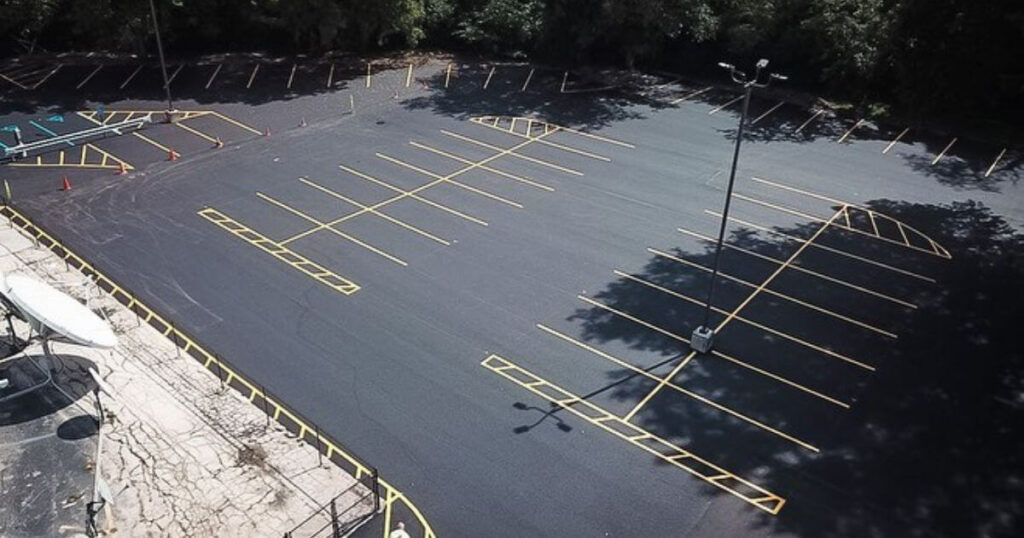
Trust Buck Bros to Construct, Maintain or Elevate Your Business’ Curb Appeal
Constructing a parking lot is a significant investment for any business, but the benefits of a well-designed, properly maintained lot are well worth the effort. By carefully considering factors like material selection, layout, safety features, and ongoing maintenance, you can create a parking lot that not only meets your functional needs but also enhances your property’s curb appeal and contributes to the overall success of your business.
Remember, your parking lot is often the first and last impression customers have of your establishment. By taking a proactive approach to parking lot construction and maintenance, you can ensure that this impression is a positive one, setting the stage for a successful business-customer relationship.
Ready to elevate your business with a top-notch parking lot? Contact Buck Bros today for expert guidance and professional construction services. Our team of experienced paving contractors is dedicated to delivering high-quality results that meet your unique needs and exceed your expectations. From material selection and design to construction and ongoing maintenance, we’re here to help you create a safe, attractive, and long-lasting parking lot that leaves a lasting impression on your customers.
Don’t wait to take the first step towards enhancing your business’s curb appeal. Contact Buck Bros today to schedule a consultation and learn how we can help bring your parking lot vision to life. Let us be your partner in creating a parking lot that not only meets your functional needs but also contributes to the overall success and growth of your business.
Frequently Asked Questions
- What is the average lifespan of a concrete parking lot compared to asphalt?
- A well-constructed and properly maintained concrete parking lot can last 25-30 years or more, while an asphalt parking lot typically has a lifespan of 15-20 years.
- How much does it typically cost to construct a new parking lot?
- The cost of constructing a new parking lot varies depending on factors like size, material choice, and site conditions. On average, asphalt parking lots cost $2-4 per square foot, while concrete lots range from $4-6 per square foot.
- What are the most important safety features to include in a parking lot design?
- Key safety features for parking lots include adequate lighting, clear signage and markings, designated pedestrian walkways, and ADA-compliant handicapped parking spaces and access routes.
- How often should I seal my parking lot?
- Asphalt parking lots should be sealcoated every 2-3 years to protect against damage and extend their lifespan. Concrete lots typically require sealing less frequently, about every 5-7 years.
- What are some signs that my parking lot needs to be repaired or replaced?
- Signs that your parking lot may need repairs or replacement include extensive cracking, potholes, rutting, drainage issues, and overall surface deterioration. If you notice any of these problems, consult with a professional paving contractor to assess the condition of your lot and recommend the appropriate course of action.
- How can I maintain my parking lot during harsh winter conditions?
- To maintain your parking lot during winter, promptly remove snow and ice, use de-icing products sparingly to minimize damage, repair any cracks or potholes before winter sets in, and ensure proper drainage to prevent water from freezing and expanding on the pavement surface.
- What are the benefits of using sustainable materials in parking lot construction?
- Sustainable materials like pervious concrete or porous asphalt can help reduce stormwater runoff, improve water quality, and recharge groundwater supplies. These materials also help to reduce the urban heat island effect and can contribute to LEED certification for your property.
- How long does the construction process usually take for a new parking lot?
- The construction timeline for a new parking lot depends on factors like size, complexity, and weather conditions. On average, a small to medium-sized lot can be completed within 1-2 weeks, while larger projects may take several weeks or more.
- What are some ADA requirements I need to consider when designing my parking lot?
- ADA requirements for parking lots include providing a sufficient number of properly sized and marked handicapped parking spaces, ensuring accessible routes from parking areas to building entrances, and meeting specific slope and surface requirements for these spaces and routes.
- How can I find a reputable contractor to handle my parking lot construction project?
- To find a reputable paving contractor, ask for recommendations from other business owners or property managers, check for proper licensing and insurance, review their portfolio of past projects, and ask for references. It’s also a good idea to get multiple bids and carefully review the scope of work before making a decision.






